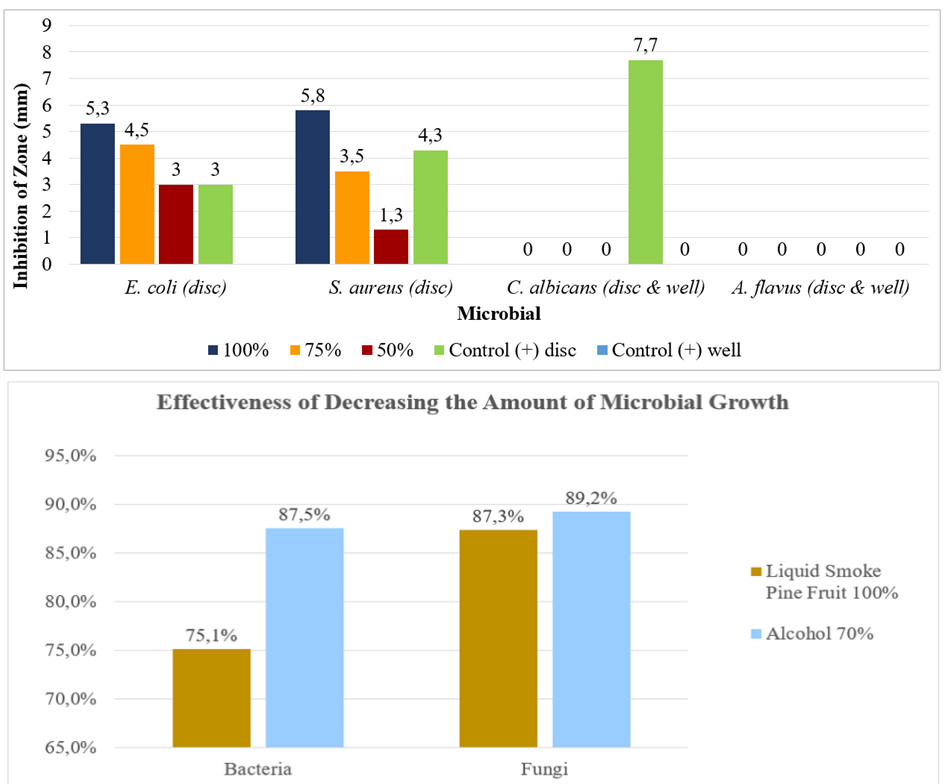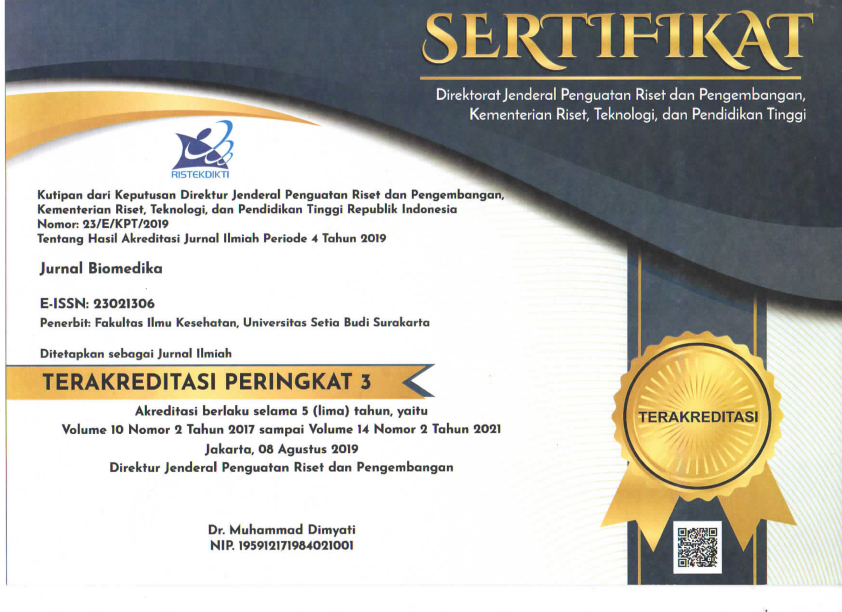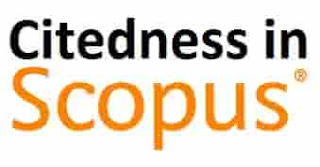Effectiveness of Antiseptic Liquid Smoke of Pine Fruit (Pinus merkusii) in Vitro and in Vivo
Abstract
Hand sanitizers containing alcohol-based components are frequently used to clean hands due to their usage is more effective and efficient. Natural substances, such as pine fruit, can be used to replace alcohol-based components. Pine fruit may be processed into an antibacterial liquid smoke product, making it potentially useful as an antiseptic. The purpose of this research is to see how effective pine fruit liquid smoke is at inhibiting microbial growth in vitro and in vivo. In vitro disc diffusion test against E. coli ATCC 25922 and Staphylococcus aureus ATCC 25923, and employing disc and well diffusion methods on Aspergillus flavus ATCC 9643 and Candida albicans ATCC 10231. The pour plate approach was used in vivo. The in vitro test findings revealed an inhibitory zone on E. coli (5.3 mm) and S. aureus (5.83 mm) from 100% concentration of liquid smoke. The in vitro test results are supported by the in vivo test results, which indicate that the liquid smoke of pine fruit is 100% effective at preventing the growth of bacteria by 75.1% and fungi by 87.7%. The results of the questionnaire indicated that respondents liked the color (50%), and aroma (58%), that the product did not induce dryness (75%), and did not burning effects (83%). The result of this research is that 100% liquid smoke of pine fruit (Pinus merkusii) is effective in inhibiting the growth of E. coli ATCC 25922 and S. aureus ATCC 25923, as well as being effective as antiseptic agents.
References
Aisyah, I. (2019). Manfaat Arang dan Asap Cair dari Limbah Biomasa. Yogyakarta: Deepublish. https://opac.perpusnas.go.id/DetailOpac.aspx?id=1227424#
Aisyah, I., Giyanto, Sinaga, M. S., Nawangsih, A. A., & Pari, G. (2018). Uji In vitro Asap Cair terhadap Ralstonia syzygii subsp. celebesensis Penyebab Penyakit Darah pada Pisang. J Fitopatol Indones, 14(4), 145-151. https://doi.org/10.14692/jfi.14.4.145
Asngad, A., Aprilia, B. R., & Nopitasari. (2018). Kualitas Gel Pembersih Tangan (Handsanitizer) dari Ekstrak Batang Pisang dengan Penambahan Alkohol, Triklosan dan Gliserin yang Berbeda Dosisnya. Bioeksperimen, 4(2), 61-70. https://doi.org/10.23917/bioeksperimen.v4i2.6888
Aznury, M., Sofiah, & Sari, R. P. (2020). Produk Gel Hand Sanitizer Berbahan Dasar Ekstrak Cair Daun Sirih Hijau (Piper betle Linn.) sebagai Antiseptik. Jurnal Kinetika, 11(1), 27-35. https://jurnal.polsri.ac.id/index.php/kimia/article/view/3107
Bertrand, B. L. (2019). Lag Phase is a Dynamic, Organized, Adaptive, and Evolvable Period That Prepares Bacteria For Cell Division. Journal of Bacteriology, 201(7), 1-21. https://doi.org/10.1128/jb.00697-18
Bowman, S. M., Piwowar, A., Dabbous, A. M., Vierula, J., & Free, S. J. (2006). Mutational Analysis of the GPI Anchor Pathway Demonstrates that GPI Anchored Proteins are Required for Cell Wall Biogenesis and Normal Hyphal Growth in Neurospora crassa. Eukaryotic Cell, 5, 187-200. https://doi.org/10.1128/ec.5.3.587-600.2006
Dediwanto, Y., Oramahi, H. A., & Nurhaida. (2020). Potensi Asap Cair Dari Kayu Bengkirai dalam Menghambat Pertumbuhan Jamur Schyzophylllum commune Secara In vitro. J Galung Tropika, 9(1), 1-9. https://doi.org/10.31850/jgt.v9i1.518
Fauziati, (2012). Pemanfaatan Asap Cair dari Cangkang Kelapa Sawit sebagai Bahan Antiseptik Pembersih Tangan Asap Cair dari Cangkang Sawit sebagai Bahan Baku Industri. Jurnal Riset Teknologi Industri, 6(12), 11-19. http://dx.doi.org/10.26578/jrti.v6i12.1513
Hasanah, U. (2017). Mengenal Aspergillosis, Infeksi Jamur Genus Aspergillus. Jurnal Keluarga Sehat Sejahtera, 15(2), 76-86. https://doi.org/10.24114/jkss.v15i2.8777
Hutasoit, D. P. (2020). Pengaruh Sanitasi Makanan dan Kontaminasi Escherichia coli terhadap Penyakit Diare. Jurnal Kesehatan Sandi Husada, 9(2), 779-786. https://doi.org/10.35816/jiskh.v12i2.399
Kalista, K. F., Chen, L. K., Wahyuningsih, R., & Rumende, C. M. (2017). Karakteristik Klinis dan Prevalensi Pasien Kandidiasis Invasif di Rumah Sakit Cipto Mangunkusumo. JPDI, 4(2), 56-61. http://dx.doi.org/10.7454/jpdi.v4i2.104
Kusuma, Y., Pinatih, K. P., & Hendrayana, M. A. (2019). Efek Sinergis Kombinasi Chlorhexidine dan Alkohol Terhadap Daya Hambat Pertumbuhan Staphylococcus aureus. E-Jurnal Medika, 8(3). https://ojs.unud.ac.id/index.php/eum/article/view/48937
Lan, H., Wu, L., Sun, R., Yang, K., Liu, Y., Wu, J., et al. (2018). Investigation of Aspergillus flavus in Animal Virulence. Toxicon, 14(5), 40-47. https://doi.org/10.1016/j.toxicon.2018.02.043
Mahjani, & Putri, D. H. (2020). Growth Curve of Endophyte Bacteria Andalas (Morus macroura Miq.) B.J.T. A-6 Isolate. Serambi Biologi, 5(1), 29-32. http://dx.doi.org/10.24036/5692RF00
Makhfirah, N., Fatimatuzzahra, C., Mardina, V., & Hakim, R. F. (2020). Pemanfaatan Bahan Alami Sebagai Upaya Penghambat Candida albicans pada Rongga Mulut. Jurnal Jeumpa, 7(2), 400-413. https://doi.org/10.33059/jj.v7i2.3005
Mardalena. (2016). Fase Pertumbuhan Isolat Bakteri Tahan Asam Laktat (BAL) Tempoyak Asal Jambi yang Disimpan pada Suhu Kamar. JSPI, 1(1), 58-66. https://doi.org/10.31186/jspi.id.11.1.58-66
Muharini, F. & Farida, S. (2017). Uji Aktivitias Antibakteri Ekstrak Etanol Tanaman Obat Suku Musi di Kabupaten Musi Banyuasin Sumatera Selatan. Jurnal Kefarmasian, 7(2), 127-135. https://doi.org/10.22435/jki.v7i2.3493
Pragita, A. S., Shafa , D. P., Nursifah, D., Rumidatul, A., Fadhila, F., & Maryana, Y. (2020). Uji Aktivitas Antimikroba Ekstrak Kulit dan Kayu Sakit Ranting Sengon Terhadap Bakteri dan Jamur. J Analis Kesehatan, 9(2), 41-48. https://www.ejurnal.poltekkes-tjk.ac.id/index.php/JANALISKES/article/view/2459
Pudja, I. R., Kencana, P. D., & Jakung, M. Y. (2020). Pengaruh Konsentrasi Asap Cair Bambu Tabah (Gigantochloa nigrociliata Buse-Kurz) dan Suhu Pemasakan terhadap Mutu Se’i Bandeng. J BETA, 8(1), 93-102. https://doi.org/10.24843/JBETA.2022.v10.i01.p16
Pulungan, A. S. (2017). Aktivitas Antijamur Ekstrak Etanol Daun Kunyit (Curcuma longa LINN) terhadap Jamur Candida albicans. Jurnal Biollink, 3(2), 120-124. https://doi.org/10.31289/biolink.v3i2.843
Purwaningsih, D. & Wulandari, D. (2021). Uji Aktivitas Antibakteri Hasil Fermentasi Bakteri Endofit Umbi Talas (Colocasia esculenta L) terhadap Bakteri Pseudomonas aeruginosa. J Sains Kes, 3(5), 750-9. https://doi.org/10.25026/jsk.v3i5.622
Risna, Y. K., Harimurti, S., Wihandayo, & Widodo. (2022). Kurva Pertumbuhan Bakteri Asam Laktat dari Saluran Pencernaan Itik Lokal Asal Aceh. JPI, 24(1), 1-7. https://doi.org/10.25077/jpi.24.1.1-7.2022
Senjaya, & Surakusumah. (2007). Potensi Ekstrak Daun Pinus (Pinus merkusii) sebagai Bioherbisida Penghambat Perkecambahan Echinochloa colonum L dan Amaranthusviridis. Jurnal Parrenial, 4(1), 1-5. https://doi.org/10.24259/perennial.v4i1.175
Setyati, W. A., Martani, E., Subagiyo , T., & Zainuddin, M. (2015). Kinetika Pertumbuhan dan Aktivitas Protease Isolat 36k dari Sedimen Ekosistem Mangrove, Karimunjawa, Jepara. J Ilmu Kelautan, 20(3), 163-169. https://doi.org/10.14710/ik.ijms.20.3.163-169
Sharah, A., Karnila, R., & Desmelati. (2015). Pembuatan Kurva Pertumbuhan Bakteri Asam Laktat yang Di Isolasi Dari Ikan Peda Kembung (Rastrelliger sp.). JOM, 2(2), 1-8. https://jom.unri.ac.id/index.php/JOMFAPERIKA/article/view/6153
WHO. (2016). The Burden Of Health Care-Associated Infection Worldwide. https://www.who.int/gpsc/country_work/gpsc_ccisc_fact_sheet_en.pdf (Diakses 20 Januari 2021).
WHO. (2017). Monitoring Health For SDSGs, Suitanable Development Goals. https://apps.who.int/iris/bitstream/handle/10665/255336/9789241565486-eng.pdf?sequence=1&isAllowed=y (Diakses 20 Januari 2021)























